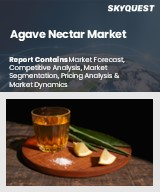
세계 아가베 넥타 시장 규모는 2023년에 1억 7,400만 달러로 평가되었으며, 2024년에는 1억 8,409만 달러, 2032년에는 2억 8,901만 달러로 성장하여 예측 기간(2025-2032년) 동안 CAGR 5.8%로 성장할 전망입니다.
세계 아가베 넥타 시장은 정제된 설탕과 인공 감미료를 대체할 수 있는 건강한 대안으로 천연 감미료에 대한 소비자의 선호도가 높아지면서 크게 성장하고 있습니다. 영양에 대한 인식이 높아지면서 소비자들은 혈당지수가 낮은 제품을 찾게 되었고, 아가베 넥타의 매력은 더욱 커지고 있습니다. 유기농 식품과 클린 라벨 식품에 대한 수요는 이 분야의 수요를 더욱 촉진하고 있습니다. 하지만, 특히 기후 조건의 변화로 인한 재배의 어려움에 직면한 블루리가베의 가용성과 가격 변동과 관련된 과제는 여전히 남아있습니다. 또한 스테비아, 메이플 시럽, 꿀 등 다른 천연 감미료와의 경쟁도 위협이 되고 있습니다. 가공 방법과 과당 함량에 대한 지속적인 논의도 소비자의 인식에 영향을 미쳐 시장 성장을 위한 복잡한 환경을 조성하고 있습니다.
Global Agave Nectar Market size was valued at USD 174.0 Million in 2023 poised to grow between USD 184.09 Million in 2024 to USD 289.01 Million by 2032, growing at a CAGR of 5.8% in the forecast period (2025-2032).
The global agave nectar market is experiencing significant growth driven by increasing consumer preference for natural sweeteners as a healthier alternative to refined sugars and artificial options. Heightened awareness of nutrition prompts consumers to seek out products with lower glycemic indices, enhancing agave nectar's appeal. The trend toward organic and clean-label foods further supports demand in this sector. However, challenges persist, particularly related to the availability and fluctuating prices of blue agave plants, which face cultivation challenges due to changing climatic conditions. Additionally, competition from other natural sweeteners like stevia, maple syrup, and honey poses a threat. Ongoing debates about processing methods and fructose content also influence consumer perceptions, creating a complex environment for market growth.
Top-down and bottom-up approaches were used to estimate and validate the size of the Global Agave Nectar market and to estimate the size of various other dependent submarkets. The research methodology used to estimate the market size includes the following details: The key players in the market were identified through secondary research, and their market shares in the respective regions were determined through primary and secondary research. This entire procedure includes the study of the annual and financial reports of the top market players and extensive interviews for key insights from industry leaders such as CEOs, VPs, directors, and marketing executives. All percentage shares split, and breakdowns were determined using secondary sources and verified through Primary sources. All possible parameters that affect the markets covered in this research study have been accounted for, viewed in extensive detail, verified through primary research, and analyzed to get the final quantitative and qualitative data.
Global Agave Nectar Market Segments Analysis
The global agave nectar market is segmented by type, application, end-user, and region. In terms of types, the market is divided into light agave nectar, dark agave nectar, amber agave nectar, and raw agave nectar. Based on Applications, the market is bifurcated into food & beverages, pharmaceuticals, and cosmetics & personal care. Based on End-user, the market is grouped into industrial, and retail. Based on region, the market is segmented into North America, Europe, Asia-Pacific, Latin America and the Middle East and Africa.
Driver of the Global Agave Nectar Market
The increasing global focus on healthier lifestyles and clean-label products significantly propels the growth of the global Agave Nectar market. Consumers are increasingly pursuing natural alternatives to refined sugars and synthetic sweeteners. Agave nectar, derived from a plant source and boasting a lower glycemic index, resonates strongly with the expanding demographic of health-conscious individuals. This trend has compelled manufacturers to incorporate agave nectar into a wider array of food products, catering to the demand for wholesome and natural ingredients. Consequently, the market is seeing a heightened interest in agave-based options as part of a broader shift towards better nutrition.
Restraints in the Global Agave Nectar Market
The global agave nectar market faces significant constraints due to its reliance on the blue agave plant, which requires a lengthy cultivation process. This reliance leads to a supply chain that is highly vulnerable to various challenges such as climate change, diseases affecting the plant, and other agricultural issues. The sensitivity of raw material supply can often result in price fluctuations and environmental impacts, limiting the availability of agave nectar. Consequently, these factors introduce inherent risks within the market, making it difficult for stakeholders to maintain stable supply chains and manage costs effectively.
Market Trends of the Global Agave Nectar Market
The global agave nectar market is witnessing a notable shift towards organic and clean-label products, driven by consumers' growing preference for transparency and healthier food options. This trend reflects a broader demand for non-GMO, sustainably sourced, and ethically produced ingredients. Brands offering certified organic agave nectar are positioned to capture the attention of health-conscious consumers, thereby enhancing their market share and trust. As eateries and retailers increasingly highlight the quality and provenance of their offerings, agave nectar, known for its low glycemic index and natural sweetness, stands out as a preferred choice, aligning perfectly with evolving consumer expectations for clean and wholesome products.